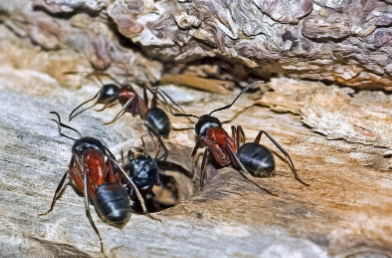Mormon Crickets
Table of Contents Mormon crickets, despite their name, are not true crickets, but a type of large insect that belongs

If you’ve ever had the misfortune of dealing with carpenter ants, you know that they can be a frustrating and persistent pest to get rid of. These large black or reddish-brown ants are known for their habit of excavating wood and causing structural damage to homes and buildings. But fear not – with the right approach, you can eliminate these pests and prevent them from coming back.
In this comprehensive guide, we’ll take a look at the various methods you can use to get rid of carpenter ants, from natural remedies to chemical treatments. But before we dive in, it’s important to understand the complexity of the task at hand.
Carpenter ant infestations can be difficult to tackle due to the intricate network of tunnels and satellite nests they create. However, armed with the knowledge of perplexity and burstiness, we’ll present you with a guide that is both informative and engaging. So let’s get started and bid those carpenter ants farewell!
Let’s first understand ants’ behavioral patterns and common habits.
Colony: Carpenter ants live in colonies which have one queen ant and thousands of worker ants. Queen ant leaves the old colonies to mate with male ant, also known as swarmer or winged ant. After that, she finds a suitable spot, i.e., moist wood excavates it, and seals the entrance to lay her eggs.
Foraging: Once the first generation develops fully, the nest is opened, and foragers begin their hunt for food. They leave a trail of pheromones connecting the food sources with the nest so other ants can follow the way to feed.
Diet: Typically, outdoor carpenter ants feed on protein and sugar sources, like dead insects and animals, honeydew, plant ooze, etc. While they also attack live insects in some instances. Ants nesting inside your home are more attracted to meat, juices, jellies, candies, bread, etc.
Lifespan: The queen’s survival period is about 15 years, while that of the worker ants is around 4 to 5 years. It is shorter because they have to go out to hunt food, which makes them more susceptible to predation and human activities.
Nocturnal activity: Carpenter ants only come out after sunset, so you will likely spot them at night.
Peak months: These pesky bugs stay active from May to October.
Carpenter ants are considered a problem for their tendency to cause structural damage inside your home. Once their satellite colonies invade your space, the ants chew soft wood to create tunnels for their nesting needs.
Although they do not feed on it like termites, this can still weaken the wood’s overall structure and integrity. If not treated promptly, damage by carpenter ants can lead to costly repairs.
Here are some common sights that indicate the presence of carpenter ants inside your home.
Carpenter ants are one of the most common types of ants found in North America. They are often larger than other ant species and are typically black, brown, red, or a combination of these colors.
One way to recognize these pests is by their distinctive body shape, which includes a narrow waist and rounded thorax. This also sets them apart from termites with thicker waists. Additionally, carpenter ants have elbowed antennae that are typically bent at a 90-degree angle.
Characteristics | Carpenter Ants | Other Ants |
Nesting habits | Tunnels in wood | Soil, leaf litter, etc. |
Body | Larger (½ to ⅝ inches long) | Smaller (0.08 to 1 inch) |
Behavior | Nocturnal | More active during the daytime |
Color | Black, brown, red or a combination of these colors | Black or red |
Body | Evenly-shaped and heart-shaped head | Unevenly shaped body and head |
Wings | Two pairs – longer front wings than back ones | Two pairs – different sizes |
You can find carpenter ants in different areas of your home; let’s briefly overview them.
Considering their damp wooden habitat, they usually nest inside your home in areas such as:
Carpenter ants are generally harmless to humans as they do not carry or transmit diseases like other pests, such as mosquitoes, ticks, or fleas. But, they can still pose a risk to your and your loved ones’ health through cross-contamination of food.
As carpenter ants scavenge for food, their bodies pick up various pathogens like bacteria and viruses. And if they come into contact with food items, they can transfer these pathogens onto them, which can lead to multiple illnesses upon consumption by humans.
It is easier not to let carpenter ants invade your home’s wooden structures just by taking a few prevention measures that we will discuss below.
Following the below tips can help you keep the carpenter ants infestation at bay:
Regular home maintenance is another crucial step to getting rid of carpenter ants completely. It will help you identify and address the major issues before they become a problem. For example, fixing plumbing leaks and repairing any water damage will reduce the moisture levels in your home. It will eventually deter away the carpenter ants from nesting indoors.
Similarly, replacing damaged or rotting wood eliminates the likelihood of carpenter ants finding a suitable site to nest. And you can also spot and resolve the cracks in your home’s foundation or around windows and doors to seal the entry of these pests inside your home.
Here are some DIY and natural strategies that will help you remove carpenter ants in your home:

If the issue persists after trying all the above-mentioned methods, you must not resist calling a professional exterminator. A licensed pest controller can identify the extent of the infestation and remove it from the root. It is only possible through addressing the underlying moisture issues and sealing the potential entry points of carpenter ants.
They rarely bite unless provoked. The carpenter ant bite is not much harmful; it only causes a minor burning sensation which gets better in a few minutes. However, individuals with sensitive skin might develop inflammation and redness of the skin, which takes around a week to heal properly.
Carpenter ants are generally less aggressive than other ant species, like fire ants or army ants. In fact, the sting of fire ants is venomous and highly painful, which might lead to severe allergic reactions in some individuals.
Carpenter ants can be a threat to the wooden structures in your home with their ability to excavate them and form tunnels. They might also contaminate your food in some instances.
Considering this, it is important to eliminate them timely. And you can achieve this successfully through some natural or DIY methods, regular home maintenance, or hiring a professional exterminator.
Table of Contents Mormon crickets, despite their name, are not true crickets, but a type of large insect that belongs
Wolf spiders are generally not dangerous to humans: While wolf spiders can bite if threatened, their venom is typically not harmful to humans.
You can get advice and tips on how to kill cockroaches in your household and get rid of this pesky infestation for good. You will learn about these insects, their habits, ways of feeding, and habitats